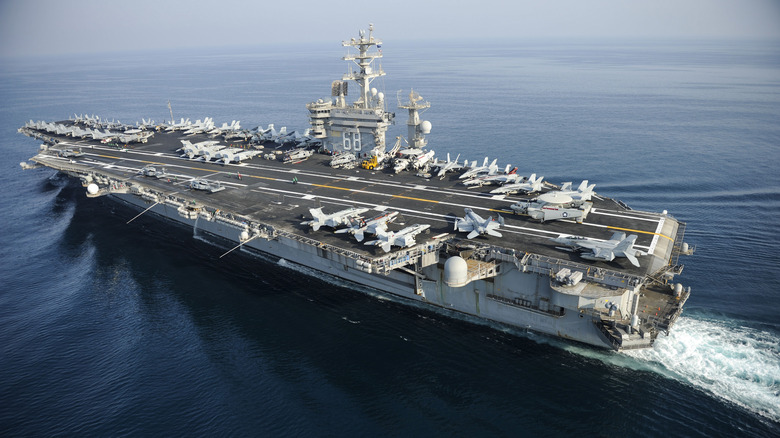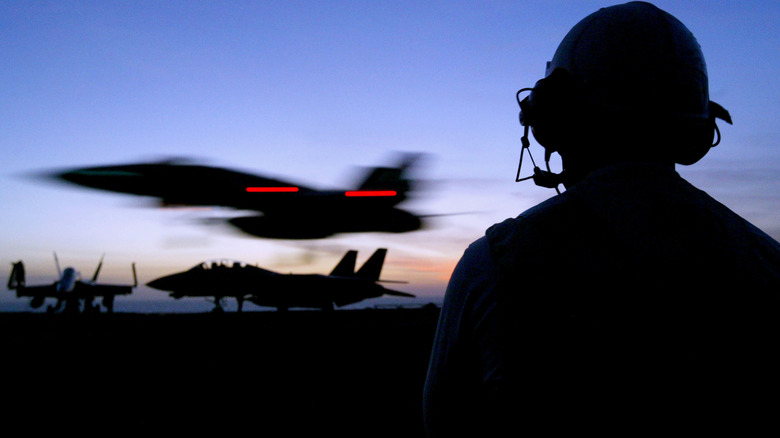Do Aircraft Carriers Store Planes Below Deck?
From the F-35 Joint Strike Fighter to the E-2D Advanced Hawkeye, aircraft carriers hold a wide variety of different aircraft. The USS Gerald R. Ford (CVN-78), the largest aircraft carrier in the world, can carry up to 90 fighter jets and helicopters. A long angled runway on the carrier helps with real estate up top, but that's not nearly enough space for 90 vehicles. Instead, the bulk of a carrier's inventory is kept below the flight deck in the hangar bay. Located below the flight deck, the hangar bay is roughly two-thirds the length of the carrier and has enough space for the jets and spare parts.
The hangar bay is like the garage for airplanes, where all the maintenance for the aircraft is conducted. It's split up into separate zones where different components can be safely tested. The aft portion of the hangar bay is reserved for the Aircraft Intermediate Maintenance Division (AIMD) shops, where the crew conducts repairs. There's also an open-air section of the hangar where the AIMD can safely test jet engines. When a plane is done with repairs and ready for flight, an elevator takes it to the flight deck.
The AIMD crew share the hangar with the V-3 division, which is in charge of hangar deck control. As the Aviation Boatswain's Mate (Handling) 1st Class Christopher Waiters explained it, that includes everything from "vehicle movement, aircraft movement, and any equipment or station related to those."
Why not store aircraft on the flight deck?
That being said, you might still be wondering why aircraft carriers don't store jets on top of the carrier. Wouldn't they be easier to access rather than having to haul them up in an elevator through multiple levels of the ship?
Besides there simply not being enough space on the flight deck for every aircraft aboard, another reason the bulk of the aircraft are stored in the hangar bay is that there is too high of a risk up there for the jets. There's a reason that's where the most dangerous job on an aircraft carrier is located. If something as small as a screw or a nut flies into a plane's engine, it can knock it out of commission entirely. That's why when a plane isn't in use, its engine's intake port is covered by an engine blank to prevent debris from entering the engine.
The flight deck crews have to be vigilant, keeping their work areas clean and accounting for all of their tools. They conduct a foreign object discovery walk (FOD) before the start of every shift, looking for anything that might pose a risk to the ongoing operations. If anyone misplaces a single item, all operations are suspended until the item is found. Thus, it's safer to keep the bulk of a carrier's aircraft inventory down in the hangar bay.
Which planes are stored below deck?
Aircraft carriers typically have several squadrons of fighter jets and reconnaissance planes. The most commonly seen U.S. Navy fighter jet is the F/A-18 Super Hornet. Its foldable wings make it easier to stuff both on the flight deck and down below in the hangar bay. Another major asset is the F-35C Lightning II, which can vertically takeoff and has stellar landing capabilities.
The USS Gerald R. Ford (CVN-78) has a squadron of EA-18G Growlers aboard, a variant of the F/A-18 designed for electronic warfare. The Growler can jam enemy radar, hide allied aircraft from detection, and block communications. When electronic warfare tactics aren't necessary, it can fulfill the same multirole as the traditional F/A-18. Also found aboard U.S. carriers is the reconnaissance E-2D Advanced Hawkeye, which can extend the range of allied radar detection systems.
Lastly, many carriers have space for a variety of helicopters, such as the MH-60R/S Seahawk, that can serve as a humanitarian support vessel. However, they primarily serve in an anti-submarine and anti-surface capacity. From time to time, some carriers like the USS Gerald R. Ford will also carry unmanned vessels like drones.


